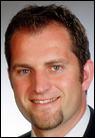One problem all end users of UHF radio frequency identification systems grapple with is how to achieve high read rates. CISC Semiconductor, a five-year-old Austrian provider of software simulation, has developed hardware and software to help companies configure readers to achieve the best possible read rates.
CISC offers two separate RFID products: a device that measures an interrogator’s RF field, and a software application that simulates an RFID interrogator’s performance. Its RFID Field Recorder is a hardware device with up to 16 RF sensors. Companies can place the sensors on cases stacked on a pallet, then push the pallet through a portal. The device measures the amount of RF energy reaching each of the sensors.
“You have reflections in the real environment, so it’s important to put sensors on the pallet, move it through the read field and measure the energy reaching the tags in different locations,” says Josef Preishuber-Pflügl, CISC’s chief technology officer and manager of RFID. “This is much easier to use than a oscilloscope, and it’s less expensive.”
The field recorder can be connected to a PC via an Ethernet port and can export information in a format usable by the software simulation. It also exports data in the common comma-separated values (CSV) format for companies that don’t want to purchase the software.
CISC’s software simulation product, RFID Application and System Design Kit, takes data about the read field and allows companies to simulate the results of changes to the reader configuration or protocol settings quickly. For instance, if a portal is set up with two antennas 1 foot above the ground on either side and two antennas 5 feet off the ground, the software will reveal which tags will be read and how often. If the positions of the antennas are changed, the software will then show the effect on the tags moving through the portal.
The software can be used to simulate UHF, high-frequency and low-frequency systems. Users can purchase modules that simulate tags using different protocols, including ISO 15693, ISO 18000-3, ISO 18000-6A and -6B, and EPC Class 1 Generation 2.
“The software will recommend optimal settings based on your needs,” Preishuber-Pflügl says. “If you are trying to read all the cases on a pallet to confirm the accuracy of a shipment against a PO before putting the pallet on the truck, the software knows the environment.”
One feature end users might find particularly valuable is the ability to simulate the effects of different settings for Gen 2-compliant interrogators. Gen 2 lets users issue “select” commands, instructing the interrogator to read only pallet tags, only case tags or only tags from a specific manufacturer. The simulation software can also show the results of choosing different settings.
In addition, there are other modules that define different application setups, such as portal configurations. The simulation application, written in C++ and MATLAB/Simulink, can be run on computers with the Windows 2000, Windows NT, Unix or Linux operating system. It costs 10,000 euros to 50,000 euros, depending on which of the eight modules are purchased. The field recorder is 5,000 euros to 10,000 euros, based on the configuration of the hardware.
Metro, the German retailer, has been using the simulation software in its Innovation Center to model different interrogator antenna configurations. “The software can save you a lot of time and money, because you don’t have to repeat tests each time you make a change,” says Preishuber-Pflügl. “For instance, if you want to see the effect of raising or lowering an antenna, you don’t have to do it physically and then run a pallet past to see how many tags were read. You can make changes in the software and see the impact.”


